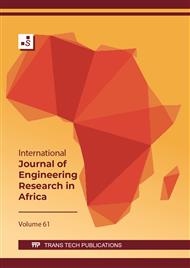[1]
M. M. Ali, and H. Kvande, Recent advances in electrical resistance preheating of aluminium reduction cells, JOM, The Journal of The Minerals, Metals and Materials Society (TMS), Vol. (2), DOI 10.1007/s11837-016-1987-x, February (2017) 266-280.
DOI: 10.1007/s11837-016-1987-x
Google Scholar
[2]
W. R. Hale, Improving the useful life of aluminum industry cathodes, JOM Journal of the Minerals, Metals and Materials Society, Vol. (41) (Nov.1989) 20-25.
DOI: 10.1007/bf03220379
Google Scholar
[3]
M. Reverdy and V. Potocnik, A historical review of aluminum reduction cell start-up and early operation, Light Metals (2022) 991-997.
DOI: 10.1007/978-3-030-92529-1_129
Google Scholar
[4]
M. Sorlie and H. Oye, Cathodes in aluminium electrolysis, 2nd edition, Aluminium –Verlag GmbH, Dusseldorf, (1994).
Google Scholar
[5]
H. Kvande, The 20th international course on process metallurgy of aluminium, NTH, Trondheim, Preheated and start-up of cells (2001) 41-79.
Google Scholar
[6]
Y. Ban et al., Baking start-up and operation practices of 400 kA prebaked anode pots, Light Metals (2010) 368-373.
Google Scholar
[7]
H. Mohammed, B. Kakkar, and A. Kumar, Improvement in cell preheat and start up at Dubal, Light Metals (2007) 997-1000.
Google Scholar
[8]
G. R. P. Stockman, Cathode preheat and startup temperatures and bottom block displacements SiC in aluminium reduction cells, Light Metals (1989) 185-190.
Google Scholar
[9]
J. Tessier, C. Duchesne, G. P. Tarcy, C. Gauthier, and G. Dufour, Increasing potlife of Hall–Heroult reduction cells through multivariate on-line monitoring of preheating, start-up, and early operation, Metallurgical and materials transactions, Vol (41B) (June 2010) 612—624.
DOI: 10.1007/s11663-010-9359-3
Google Scholar
[10]
M. Reverdy, The international course on process metallurgy of aluminium, NTH, Trondheim, Preheating, start-up and early operation of Hall-Heroult cells, (1993) 10-1 to 10-60.
Google Scholar
[11]
M. Taylor, B. Welch, and J. Keniry, Influence of changing process conditions on the heat transfer during the early life of an operating cell, Light Metals (1983) 437-447.
Google Scholar
[12]
A.V. Zavadyak, et al., Proceedings of XXXI International Conference ICSOBA and XIX International Conference Aluminium of Siberia, Electric preheating of the RA-400 cell Sep. 4–6, (2013), Krasnoyarsk, Russia, 602–608.
Google Scholar
[13]
A. Alzarooni, et al., DX+ Ultra industrial version: Preheat, start-up and early operation, Light Metals (2018) 721–729.
DOI: 10.1007/978-3-319-72284-9_93
Google Scholar
[14]
M. Reverdy, et al. The successful implementation of EGA DX+ Ultra technology at ALBA. Proceedings of the 38th International ICSOBA Conference, (16–18 Nov.2020), Travaux 49, 539–549.
Google Scholar
[15]
M. Deshaies, C. Bourbonière and C. Guérette, An overview of ABI's experience with Pechiney 180 kA cells, Light Metals (1992) 337–341.
Google Scholar
[16]
K. Youssif, Study of the thermal behavior of aluminium reduction cells during the early potlife period, M.Sc. thesis, Assiut University, (2020).
Google Scholar
[17]
G. A. Abdalla, K. Youssif, E. A. Elbadry, and M.M. Ali, Thermal analysis of the baking and start-up stages for Hall –Héroult cells at Egyptalum smelter, Journal of Petroleum and Mining Engineering 22(2) (2020).
DOI: 10.21608/jpme.2020.30541.1033
Google Scholar
[18]
H. Kvande and W. Haupin, Cell voltage in aluminum electrolysis: a practical approach, JOM Journal of the Minerals, Metals and Materials Society, Vol. (52) (Nov.2000) 31-37.
DOI: 10.1007/s11837-000-0044-x
Google Scholar
[19]
C. V. Giovanni, AP35: The latest high performance industrially available new cell technology, Light Metals (2002) 506-51.
DOI: 10.1002/9781118647851.ch74
Google Scholar
[20]
M. A. Doheim, A. M. El-Kersh, and M. M. Ali, Computational modeling of flow in aluminium reduction cells due to gas bubbles and electromagnetic forces, Metallurgical and Materials Transactions B, Vol 38B, (Feb.2007) 113-119.
DOI: 10.1007/s11663-006-9014-1
Google Scholar
[21]
Z. Shuiping, et al, Analysis of the start-up of Q-350 prebaked aluminum reduction cells, Light Metals (2006) 271-275.
Google Scholar
[22]
J. Ghosh, A. Steube, and B. Levenig, From 110 to 175 kA: Retrofit of VAW Rheinwerk Part II: construction & operation, Light Metals (2016) 485-488.
DOI: 10.1007/978-3-319-48156-2_70
Google Scholar
[23]
S. McFadden, et al., Application of advanced process control to aluminium reduction cells A review, Light Metals (2001) 1233-1238.
Google Scholar
[24]
B. Gao, D. Li, Z. Shi, Z. Wang, B. Ren, Determination of cryolite ratio of aluminum electrolytes, Light Metals (2010) 569-573.
Google Scholar
[25]
M. Reverdy, 27th International Course on Process Metallurgy of Aluminium, NTH, Trondheim, Potline operation, Vol. (1) (2008) 47- 75.
Google Scholar
[26]
H. A. Øye, The 27th international course on process metallurgy of aluminium, NTH, Trondheim, Aluminum electrolysis principles and environmental concerns (2008) 1- 40.
Google Scholar
[27]
A. Tabereaux, The 27th international course on process metallurgy of aluminium, NTH, Trondheim, Current Efficiency (2008) 1- 30.
Google Scholar
[28]
Z. Shuiping, W. Shasha, Q. Yaxing, Control of temperature and aluminum fluoride concentration based on model prediction in aluminium electrolysis, Advances in materials science and engineering, Vol. 3 (2014) 1-5.
DOI: 10.1155/2014/181905
Google Scholar
[29]
Q. Zhuxian, Prebake Aluminum Production, Metallurgy Press, Beijing, China,3rd edition,(2005).
Google Scholar
[30]
K.l Å. Rye, The international course on process metallurgy of aluminium, NTH, Trondheim, Electrolyte composition. options and desirable properties, (2008) 1-10.
Google Scholar
[31]
Y. HUANG, X. QU, J. ZHOU, Coupled heat/mass-balance model for analyzing correlation between excess AlF3 concentration and aluminum electrolyte temperature, Transactions of Nonferrous Metals Society of China, Volume 19, Issue 3, (June 2009) 724-729.
DOI: 10.1016/s1003-6326(08)60340-4
Google Scholar
[32]
J. G.Peacy & G.W. Medlin, Cell sidewall studies at Noranda Aluminium, Light Metals (1979) 475-492.
Google Scholar
[33]
A. Ugron, L. I. Kiss, J. F. Bilodeau, S. Guerard, Non-intrusive freeze layer detection method in an aluminum reduction cell, Light Metals (2015) 571-576.
DOI: 10.1002/9781119093435.ch95
Google Scholar
[34]
T. A. Utigard, et al., Heat and mass transfer between liquid and bath solid cryolite ledge, Proceedings of the international symposium on reduction and casting of aluminum, Canadian institute of mining and metallurgy, (1988) 163-176.
DOI: 10.1016/b978-0-08-041444-7.50020-2
Google Scholar
[35]
K. Ghuloom, A. Habib, K.S.R. Raghavendra, H. Hassan, Improving current efficiency of aged reduction lines at aluminium Bahrain (Alba), Light Metals (2011) 449-453.
DOI: 10.1002/9781118061992.ch80
Google Scholar


